CL. RE D'ITALIA
RE D’ITALIA e RE DI PORTOGALLO, due unità navali con scafo in legno di quercia bianca che formavano la classe RE D’ITALIA.
Di circa 100 mt. di lunghezza f.t. e di oltre 5.700 ton, di dislocamento furono varate nel 1863 presso i cantieri navali Webb di New York come pirofregate corazzate, attrezzate da brigantino a palo, munite di tre alberi e bompresso e dotate, durante la navigazione a vela, di un fumaiolo retrattile e di un’elica bipala a scomparsa, alloggiata in un pozzetto a poppa.
Esaminando il profilo esterno delle unità si rileva:
• un rostro/sperone di ferro fuso posto, a prora, a 2 mt. di profondità dalla linea di galleggiamento e fuoriuscente dalla linea del tagliamare di 180 cm;
• il fasciame esterno in legno rivestito con piastre metalliche da 120 mm;
• la maggior parte della testa del timone, a poppa, non protetta e posta in vista al di sopra del galleggiamento.
Il ponte di coperta, infine, era ricoperto da uno strato di lamiera di ferro spesso 10 mm.
L’ armamento principale, costituito da 36 cannoni ad avancarica, disposti per la quasi totalità, sulle due fiancate del ponte di batteria, era composto da:
• n.2 cannone rigati da 300 libbre.
• n.30 cannoni rigati ad avancarica da 40 libbre,
• n.4 cannoni lisci ad avancarica da 80 libbre.
Le due unità parteciparono alla battaglia di Lissa del 20 luglio 1866:
• il RE D’ITALIA, impossibilitato a manovrare con il timone fuori uso probabilmente colpito da una granata, fu speronato ed affondato dalla pirofregata SMS Erzherzog Ferdinand Max;
• il RE DI PORTOGALLO, pur danneggiato seriamente dallo speronamento del pirovascello SMS Kaiser, riuscì a disimpegnarsi. Venne radiato e demolito nel 1875.
KING OF ITALY CLASS
RE D'ITALIA and RE DI PORTOGALLO, two naval units with white oak wood hulls that formed the RE D'ITALIA class.
About 100 mt. and of over 5,700 tons, of displacement were launched in 1863 at the Webb shipyards in New York as armored steamers, equipped with a brigantine pole with, three masts and bowsprit and, during sailing, with retractable funnel and a two-blade propeller, housed in a cockpit at the stern.
Examining the external profile of the units shows:
• a rostrum/spur of molten iron placed, at a bow, at 2 meters. depth from the waterline and protruding from the line of the cutter by 180 cm;
• the external wooden planking covered with 120 mm metal plates;
• Most of the rudder head, at the stern, unprotected and placed in view above the waterline.
Finally, the main deck was covered with a layer of 10 mm thick iron sheet.
The main armament, consisting of 36 muzzle-loading guns, entirely arranged on the two sides of the battery deck, consisted of:
• n.2 300-pound rifled gun.
• n.30 40-pounder muzzle-loading rifled guns,
• n.4 80-pound muzzle-loading smoothbore cannons.
The two units participated in the Battle of Lissa on 20 July 1866:
• the RE D'ITALIA, unable to manoeuvre with the rudder out of order probably hit by a grenade, was rammed and sunk by the steamer SMS Erzherzog Ferdinand Max;
• the KING OF PORTUGAL, although seriously damaged by the ramming of the steamer SMS Kaiser, managed to disengage. It was decommissioned and scrapped in 1875.
Di circa 100 mt. di lunghezza f.t. e di oltre 5.700 ton, di dislocamento furono varate nel 1863 presso i cantieri navali Webb di New York come pirofregate corazzate, attrezzate da brigantino a palo, munite di tre alberi e bompresso e dotate, durante la navigazione a vela, di un fumaiolo retrattile e di un’elica bipala a scomparsa, alloggiata in un pozzetto a poppa.
Esaminando il profilo esterno delle unità si rileva:
• un rostro/sperone di ferro fuso posto, a prora, a 2 mt. di profondità dalla linea di galleggiamento e fuoriuscente dalla linea del tagliamare di 180 cm;
• il fasciame esterno in legno rivestito con piastre metalliche da 120 mm;
• la maggior parte della testa del timone, a poppa, non protetta e posta in vista al di sopra del galleggiamento.
Il ponte di coperta, infine, era ricoperto da uno strato di lamiera di ferro spesso 10 mm.
L’ armamento principale, costituito da 36 cannoni ad avancarica, disposti per la quasi totalità, sulle due fiancate del ponte di batteria, era composto da:
• n.2 cannone rigati da 300 libbre.
• n.30 cannoni rigati ad avancarica da 40 libbre,
• n.4 cannoni lisci ad avancarica da 80 libbre.
Le due unità parteciparono alla battaglia di Lissa del 20 luglio 1866:
• il RE D’ITALIA, impossibilitato a manovrare con il timone fuori uso probabilmente colpito da una granata, fu speronato ed affondato dalla pirofregata SMS Erzherzog Ferdinand Max;
• il RE DI PORTOGALLO, pur danneggiato seriamente dallo speronamento del pirovascello SMS Kaiser, riuscì a disimpegnarsi. Venne radiato e demolito nel 1875.
KING OF ITALY CLASS
RE D'ITALIA and RE DI PORTOGALLO, two naval units with white oak wood hulls that formed the RE D'ITALIA class.
About 100 mt. and of over 5,700 tons, of displacement were launched in 1863 at the Webb shipyards in New York as armored steamers, equipped with a brigantine pole with, three masts and bowsprit and, during sailing, with retractable funnel and a two-blade propeller, housed in a cockpit at the stern.
Examining the external profile of the units shows:
• a rostrum/spur of molten iron placed, at a bow, at 2 meters. depth from the waterline and protruding from the line of the cutter by 180 cm;
• the external wooden planking covered with 120 mm metal plates;
• Most of the rudder head, at the stern, unprotected and placed in view above the waterline.
Finally, the main deck was covered with a layer of 10 mm thick iron sheet.
The main armament, consisting of 36 muzzle-loading guns, entirely arranged on the two sides of the battery deck, consisted of:
• n.2 300-pound rifled gun.
• n.30 40-pounder muzzle-loading rifled guns,
• n.4 80-pound muzzle-loading smoothbore cannons.
The two units participated in the Battle of Lissa on 20 July 1866:
• the RE D'ITALIA, unable to manoeuvre with the rudder out of order probably hit by a grenade, was rammed and sunk by the steamer SMS Erzherzog Ferdinand Max;
• the KING OF PORTUGAL, although seriously damaged by the ramming of the steamer SMS Kaiser, managed to disengage. It was decommissioned and scrapped in 1875.
-
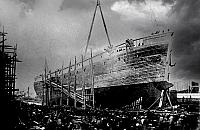
RE D'ITALIA
-

RE D'ITALIA
-
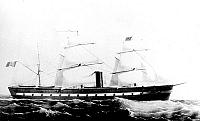
RE D'ITALIA
-
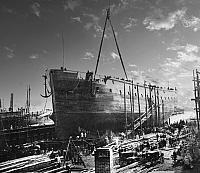
RE DI PORTOGALL…
-
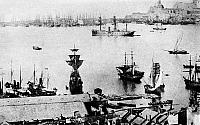
RE DI PORTOGALL…
-
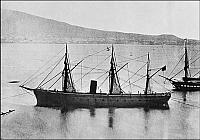
RE DI PORTOGALL…
-
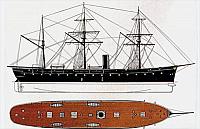
CL. RE D'ITALIA
- Primo Precedente
- Foto 1 - 7 di 7
- Prossimo Ultimo
